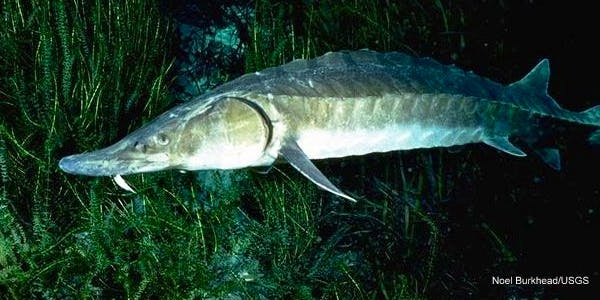Defenders of Wildlife has set itself the goal of moving more than 100 endangered species up the federal recovery ladder over the next decade. Our “Road to Recovery” series will highlight several of these plants and animals and outline the challenges that lay ahead for improving their status.
A giant fish older than T. rex
 The Gulf sturgeon (Acipenser oxyrinchus desotoi) is a living dinosaur. This enormous fish evolved from a species that has been around for more than 200 million years, long before Triceratops horridus and Tyrannosaurus rex roamed North America. Yet the sturgeon was once close to disappearing forever, just like its distant dinosaur cousins.
The Gulf sturgeon (Acipenser oxyrinchus desotoi) is a living dinosaur. This enormous fish evolved from a species that has been around for more than 200 million years, long before Triceratops horridus and Tyrannosaurus rex roamed North America. Yet the sturgeon was once close to disappearing forever, just like its distant dinosaur cousins.
The Gulf sturgeon lives along the Gulf of Mexico from Louisiana to Florida, inhabiting long, free-flowing rivers. These ancient beasts can grow more than nine feet long and often weigh over 300 pounds, with rows of armored plates lining their sides and back. Despite their intimidating size and appearance, however, sturgeon possess no teeth. Instead, they feed by sucking in small mollusks, worms and crustaceans from the bottom of the ocean. Sturgeon are also anadromous like salmon, meaning adults spawn upriver in freshwater and migrate downstream to the Gulf in fall to find food and wait out the colder winter months.
Because they’re so large, not a serious threat to humans and lay thousands of eggs at a time, sturgeon have been considered a valuable commodity for hundreds of years. They’re relatively easy to catch and can provide a huge amount of meat for food, as well as roe for caviar. As a result of over-fishing, their numbers declined drastically by the late 1800s all across the continent. First identified in 1955 as a separate subspecies from the Atlantic sturgeon, Gulf sturgeon have been protected by Florida law since 1984 and federally listed as a threatened species since 1991.

Gulf sturgeon critical habitat (show in red).
Under the ESA, it is now illegal to kill Gulf sturgeon, which has already made a huge difference for the species and put it well down the road to recovery. However, there are other complicating factors and looming threats. First, sturgeon reproduce relatively slowly, so it will take a while for numbers to rebound. They don’t reach sexual maturity until 7 to 18 years of age, and, though females can spawn multiple times during their lifetime, very few will survive to adulthood. Second, the building of dams and other water projects prevents sturgeon from migrating upstream for spawning. Third, the rivers that sturgeon call home have become increasingly inhospitable as agricultural runoff and other forms of pollution cause algae buildup, which deprives aquatic ecosystems of the oxygen that fish need to survive.
The Gulf Sturgeon Recovery and Management Plan created in 1995 outlined a plan to restore the sturgeon to healthier levels. The plan establishes goals to prevent the further reduction of existing wild populations and sets population recovery objectives capable of sustaining commercial fishing. Then in 2002, more than 1,700 river miles (over 2,300 square miles) were designated as critical habitat for the species, which prevents new projects from destroying areas vital to the species survival.
Conservation partners such as the U.S. Army Corps of Engineers, the Air Force, state wildlife agencies and local universities are also contributing efforts to preserve Gulf sturgeon. For example, some collaborators are investigating the effectiveness of “conservation locking” – creating a lock that can move fish upstream to important spawning habitat. The idea is to create an inexpensive fish elevator to replace the far more expensive fish ladders that are used elsewhere. It has worked for much smaller species like the Alabama shad and could hold promise for Gulf sturgeon too.
Here’s a short video that shows efforts to track the sturgeon population in Florida:
Though once on the brink of extinction, Gulf sturgeon have proven to be quite resilient– that’s probably how the species has survived for 200 million years! Populations are now thriving in rivers such as the Suwannee River in Florida, which currently contains about 14,000 sturgeon, though other rivers along the Gulf coast still only contain a few hundred to a few thousand. But with better river and fishery management and ecosystem protections in place, it should only be a matter of time before Gulf sturgeon make a full recovery.



